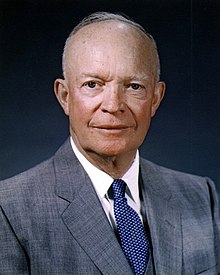
Back Еизенхауер, Дуаиҭ Девид Abkhazian Dwight D. Eisenhower Afrikaans Dwight D. Eisenhower ALS ድዋይት አይዘንሃወር Amharic Dwight David Eisenhower AN Dwight D. Eisenhower ANG دوايت أيزنهاور Arabic دوايت أيزنهاور ARY دوايت ايزينهاور ARZ Dwight D. Eisenhower AST
Dwight D. Eisenhower | |
|---|---|
 Official portrait, 1959 | |
| 34th President of the United States | |
| In office January 20, 1953 – January 20, 1961 | |
| Vice President | Richard Nixon |
| Preceded by | Harry S. Truman |
| Succeeded by | John F. Kennedy |
| 1st Supreme Allied Commander Europe | |
| In office April 2, 1951 – May 30, 1952 | |
| President | Harry S. Truman |
| Deputy | Arthur Tedder |
| Preceded by | Position established |
| Succeeded by | Matthew Ridgway |
| 16th Chief of Staff of the Army | |
| In office November 19, 1945 – February 6, 1948 | |
| President | Harry S. Truman |
| Deputy | J. Lawton Collins |
| Preceded by | George Marshall |
| Succeeded by | Omar Bradley |
| Military Governor of the U.S. Occupation Zone in Germany | |
| In office May 8, 1945 – November 10, 1945 | |
| President | Harry S. Truman |
| Preceded by | Position established |
| Succeeded by | George S. Patton (acting) |
| 13th President of Columbia University | |
| In office June 7, 1948 – January 19, 1953 | |
| Preceded by | Frank D. Fackenthal (acting) |
| Succeeded by | Grayson L. Kirk |
| Personal details | |
| Born | Dwight David Eisenhower October 14, 1890 Denison, Texas, U.S. |
| Died | March 28, 1969 (aged 78) Washington, D.C., U.S. |
| Resting place | Dwight D. Eisenhower Presidential Library and Museum |
| Political party | Republican |
| Height | 1.78 m (5 ft 10 in) |
| Spouse(s) | |
| Relations |
|
| Children |
|
| Parents |
|
| Education | United States Military Academy (BS) |
| Signature | |
| Military service | |
| Branch/service | |
| Years of service |
|
| Rank | |
| Battles/wars | |
| Awards | |
Dwight David "Ike" Eisenhower(/ˈaɪzənhaʊ.ər/ EYE-zən-how-ər (October 14, 1890 – March 28, 1969) was the 34th president of the United States, from 1953 to 1961. He was known across the world for his help leading the Allied invasions in World War II.
- ↑ "The Eisenhower Presidential Library and Museum Homepage". Eisenhower.utexas.edu. Archived from the original on October 23, 2013. Retrieved September 5, 2012.